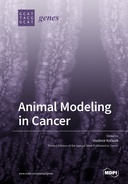Explore

Animal Modeling in Cancer
0 Ungluers have
Faved this Work
Login to Fave
Dear Readers, Understanding the pathological mechanisms involved in human diseases and their possible treatment has been historically based on comparative analysis of diverse animal species that share a similar genetic, physiological and behavioural composition. The ancient Greeks were the first to use animals as models for anatomy and physiology, and this was consequently adopted by other cultures and led to important discoveries. In recent years, there have been many efforts to understand and fight cancer through new revolutionary personalized treatments and wider screenings that help diagnose and treat cancer. A fundamental part of this effort is to develop suitable cancer animal models that simulate the different disease variants and their progression. Ranging from tumor-derived xenografts to genetically engineered models, a wide variety of systems are applied for this purpose, and many technological breakthroughs are changing the way cancer is studied and analyzed. In this Special Issue, we collected a set of research articles and reviews that focus on the generation of cancer animal models that are used for understanding the disease and contribute to designing and testing new drugs for cancer prevention or treatment. Vladimir Korinek Collection Editor
This book is included in DOAB.
Why read this book? Have your say.
You must be logged in to comment.
Rights Information
Are you the author or publisher of this work? If so, you can claim it as yours by registering as an Unglue.it rights holder.Downloads
This work has been downloaded 115 times via unglue.it ebook links.
- 115 - pdf (CC BY) at Unglue.it.
Keywords
- animal model
- Animal Models
- antitumor immunity
- Biology, Life Sciences
- brain and nervous system cancers
- CALR
- Cancer
- carcinoma
- Cdx
- chemical carcinogens
- colorectal cancer
- consensus molecular subtypes
- devitalization
- Drosophila
- drug screen
- epigenetics
- ETO-1
- FLT3 ITD
- Gene editing
- gene inactivation
- Genetics
- hematologic malignancies
- IDH1/2
- intestine
- iPSCs
- isoflavones
- JAK2
- mammary tumor prevention
- Mathematics & science
- Melanoma
- MeLiM
- metaplasia
- Mice
- microbiota
- mouse model
- mouse models
- MPL
- MPN (myeloproliferative neoplasms)
- Mutation
- Neural Stem Cells
- neurogenic niches
- non-mouse models
- NPM-1
- Oncogenes
- pre-clinical cancer model
- progression
- Radiotherapy
- Rats
- Reference, information & interdisciplinary subjects
- Research & information: general
- rodent models
- signaling cascades
- solid tumors
- soy
- sparing of neurogenic regions
- spontaneous regression
- Stem Cells
- Swine
- Thrombosis
- transgenic mice
- tumor suppressors
- tumorigenesis
- ubiquitin–proteasome system
- xenotransplantation
- Zebrafish
Links
DOI: 10.3390/books978-3-0365-1277-8Editions

